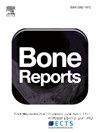类风湿性关节炎患者骨小梁评分、10 年骨折概率风险与脊椎骨折之间的关系
IF 2.6
Q3 ENDOCRINOLOGY & METABOLISM
引用次数: 0
摘要
目的 评估类风湿关节炎(RA)患者的骨小梁评分(TBS)、骨折风险评估工具(FRAX)和经 TBS 调整的 FRAX 与流行性脊椎骨折(VFs)的相关性和预测价值。临床数据和实验室检查在双能 X 射线吸收仪(DXA)扫描的同一天收集。通过 DXA 扫描获得 TBS、骨矿物质密度 (BMD) 和椎体骨折评估 (VFA)。我们使用 FRAX 工具来评估有无 BMD 的 10 年重大骨质疏松性骨折(MOF-FRAX)和髋部骨折(HF-FRAX)的概率。这些参数根据 TBS 进行了进一步调整。普遍存在VFs的患者被定义为T4至L4存在中度至重度VFs的患者。在逻辑回归和接受操作者特征(ROC)曲线分析中,VFs 的存在被用作二元变量。平均 TBS 为 1.328 ± 0.104。根据世界卫生组织的标准,39 名患者(56.5%)患有骨质疏松症,6 名患者(8.7%)患有 VF,以胸廓为主(66.67%)。单变量和多变量逻辑回归分析未显示 TBS 与椎体骨折之间存在关联,但 FRAX 评分显示两者之间存在关联。有 BMD 的 MOF-FRAX 评分、无 BMD 的 MOF-FRAX 评分、TBS 调整后的 MOF-FRAX 评分和 TBS 的曲线下面积(AUC)和 95 % 置信区间(CI)分别为 0.837 [0.686-0.988], 0.结论在我们的 RA 患者中,FRAX 评分与椎体骨折(VFs)相关,而 TBS 不相关。在该人群中,MOF-FRAX 评分与 BMD 相结合,显示出最佳的 VFs AUC。本文章由计算机程序翻译,如有差异,请以英文原文为准。
Association between trabecular bone score, 10-year probability risk for fracture, and vertebral fractures in rheumatoid arthritis
Objectives
The aim was to assess the association and predictive value of trabecular bone score (TBS), fracture risk assessment tool (FRAX), and TBS-adjusted FRAX with prevalent vertebral fractures (VFs) in patients with rheumatoid arthritis (RA).
Methods
Patients diagnosed with RA were included in this cross-sectional study. Clinical data and laboratory tests were collected on the same day as the dual-energy x-ray absorptiometry (DXA) scan. TBS, bone mineral density (BMD), and vertebral fracture assessment (VFA) were obtained from the DXA scan. We used the FRAX tool to assess the 10-year probability of major osteoporotic fracture (MOF-FRAX) and hip fracture (HF-FRAX) with and without BMD. These parameters were further adjusted for TBS. Patients with prevalent VFs were defined as those with moderate to severe VFs from T4 to L4. VFs presence was used as the binary variable in the logistic regressions and receiving operator characteristics (ROC) curves analysis.
Results
Sixty-nine patients were enrolled, with 55.1 % being postmenopausal. The mean TBS was 1.328 ± 0.104. Osteoporosis according to the WHO criteria was present in 39 patients (56.5 %), and six patients (8.7 %) had VFs with thoracic predominance (66.67 %). Univariate and multivariate logistic regression analyses did not show an association between TBS and vertebral fractures, but FRAX scores indicated such an association. The area under the curve (AUC) with 95 % confidence intervals (CI) for the MOF-FRAX score with BMD, MOF-FRAX score without BMD, TBS-adjusted MOF-FRAX score, and TBS were 0.837 [0.686–0.988], 0.795 [0.629–0.961], 0.778 [0.571–0.984], and 0.515 [0.298–0.731], respectively.
Conclusion
In our RA patients, FRAX scores were associated with vertebral fractures (VFs), while TBS was not. The MOF-FRAX score combined with BMD, showed the best AUC for VFs in this population.
求助全文
通过发布文献求助,成功后即可免费获取论文全文。
去求助
来源期刊

Bone Reports
Medicine-Orthopedics and Sports Medicine
CiteScore
4.30
自引率
4.00%
发文量
444
审稿时长
57 days
期刊介绍:
Bone Reports is an interdisciplinary forum for the rapid publication of Original Research Articles and Case Reports across basic, translational and clinical aspects of bone and mineral metabolism. The journal publishes papers that are scientifically sound, with the peer review process focused principally on verifying sound methodologies, and correct data analysis and interpretation. We welcome studies either replicating or failing to replicate a previous study, and null findings. We fulfil a critical and current need to enhance research by publishing reproducibility studies and null findings.
 求助内容:
求助内容: 应助结果提醒方式:
应助结果提醒方式:


